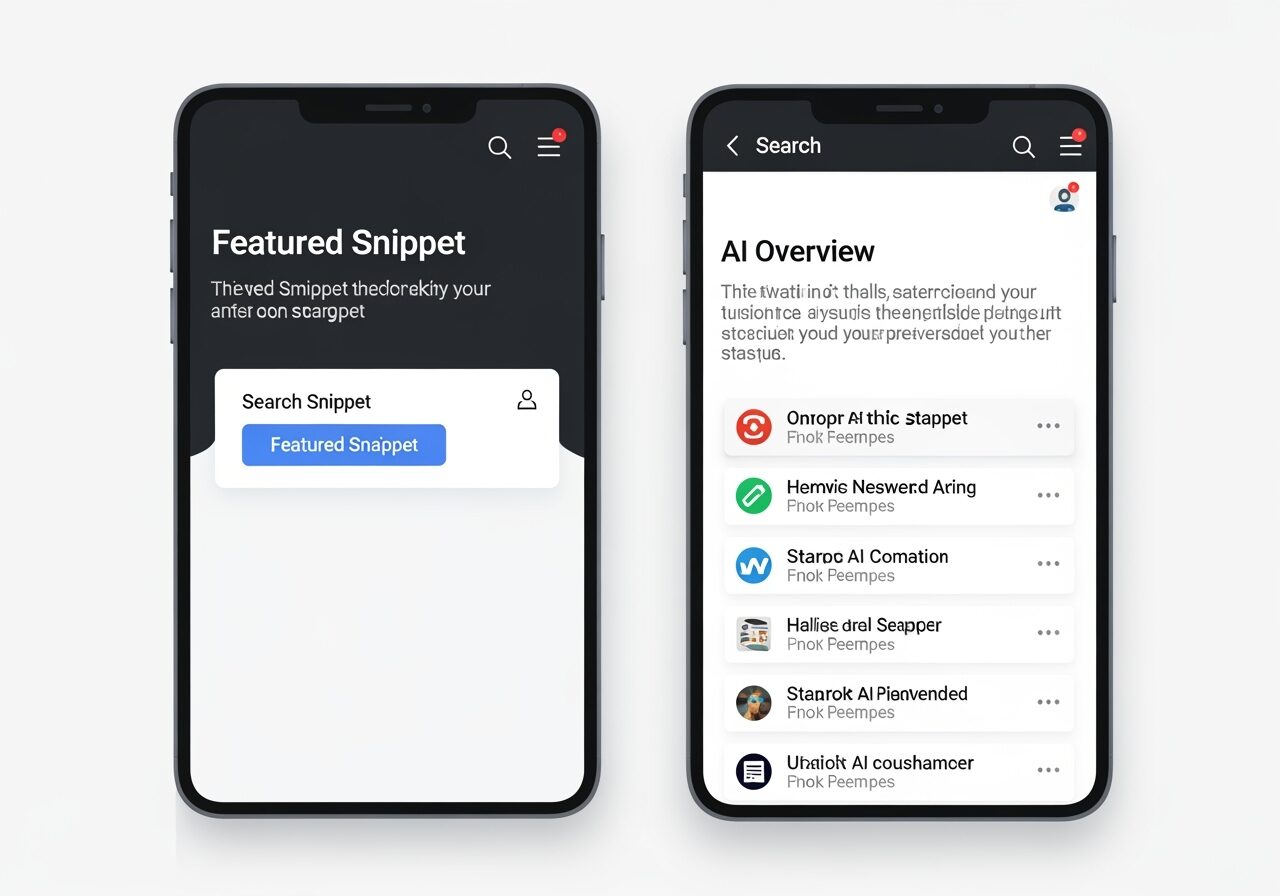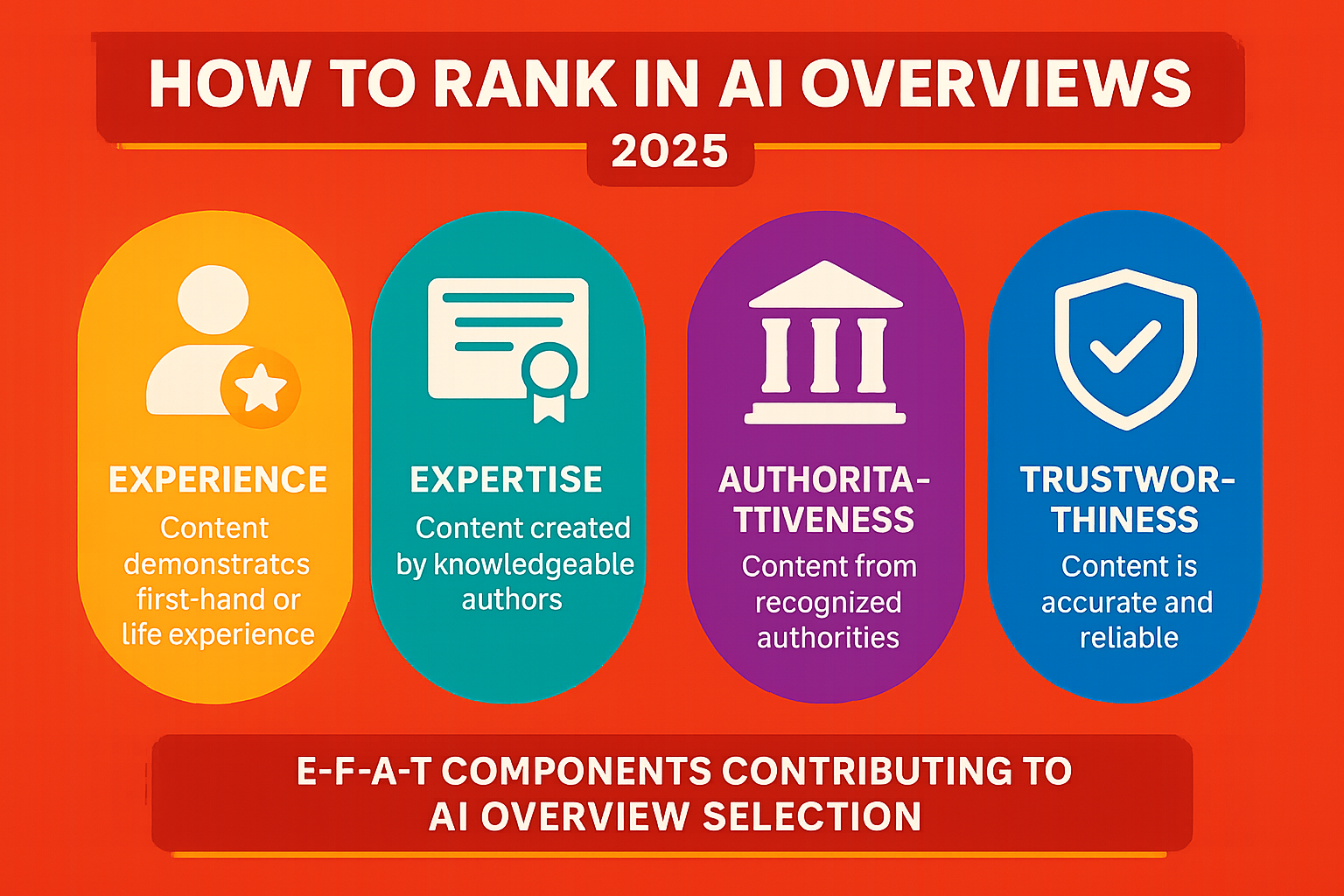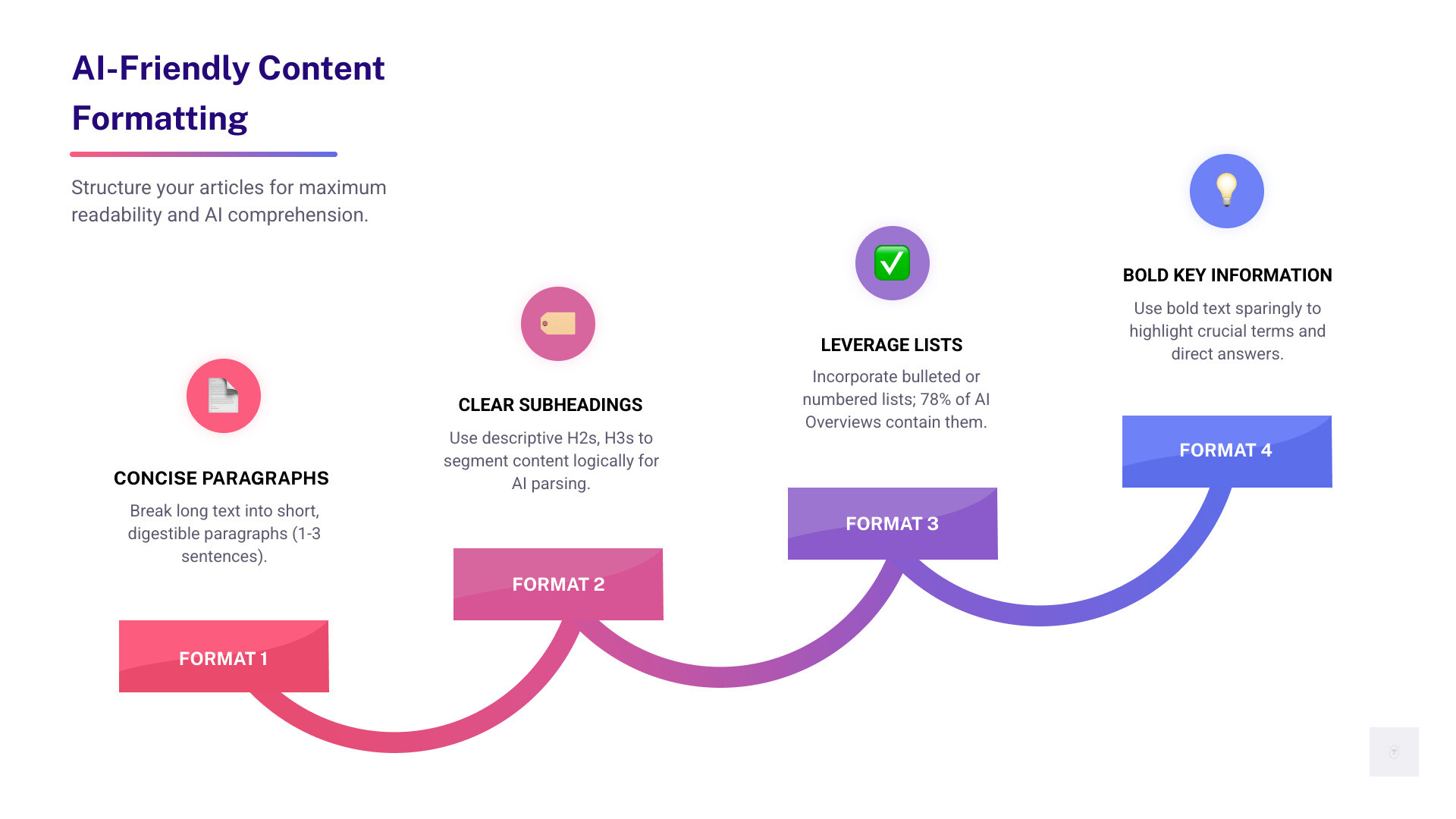TL;DR: AI Overviews appear at the very top of search results, summarizing information from multiple sources. This can reduce clicks for some queries but also offers a new, highly visible placement for authoritative content.
Google’s AI Overviews, formerly known as Search Generative Experience (SGE), are AI-generated summaries that answer a user’s query directly on the search results page. They represent a significant evolution in how search results are presented. Unlike traditional featured snippets, which typically pull a concise answer from a single, highly relevant source, AI Overviews synthesize information from multiple web pages to create a more comprehensive, often multi-paragraph, answer. They can include lists, tables, and even interactive elements, aiming to provide a complete answer without the user needing to click through to an external website.
This feature fundamentally changes the user journey. By providing a direct and often exhaustive answer, AI Overviews can lead to more “zero-click searches.” This means the user gets the information they need directly from the search results page, potentially reducing clicks to organic listings. This shift has understandably raised concerns among website owners about potential traffic loss. However, it’s crucial to recognize that AI Overviews also prominently feature clickable links to their source pages, often citing up to eight sources. This creates a new, highly visible opportunity for brands to earn unparalleled visibility and establish their site as an authority in their niche. The key, therefore, is to ensure your content is among those cited sources. It’s a prime new spot to be seen, and adapting your SEO strategy to secure this position is paramount for future online visibility.

The Core Principles: How AI Overviews Select Content
TL;DR: AI Overviews prioritize content from pages that already rank on the first page of Google, combining signals of topical authority, trustworthiness (E-E-A-T), and factual consensus across multiple high-quality sources.
Google’s system for creating AI Overviews relies heavily on its existing ranking algorithms and a sophisticated process known as Retrieval-Augmented Generation (RAG). The AI doesn’t just “make up” answers. Instead, it first retrieves a set of highly-trusted, relevant web pages from Google’s vast index – typically those already performing well in traditional organic search. It then uses this retrieved information to generate its summary. A critical component of this process is identifying a strong consensus among these top sources to ensure the information presented is accurate and reliable. This means that if your content is to be cited, it must not only be high-quality but also align with the generally accepted facts and information on a given topic.
The Strong Link Between SERP Rank and AI Inclusion
Your existing SEO efforts are not just relevant; they are the absolute foundation for ranking in AI Overviews. Studies and observations consistently show a direct and powerful correlation between high organic rankings and the likelihood of a page being included in an AI Overview. The closer you are to the top of the traditional search results, the higher your chances.
Consider these compelling statistics:
- A webpage ranked in Position 1 on the SERPs has a significant 53% chance of being included in Google’s AI Overviews.
- Even a page in Position 10 still maintains a respectable 36.9% chance.
- Furthermore, recent analyses indicate a remarkable 99% overlap between sources cited in AI Overviews and the organic results found on the first page of Google. This means that if your content isn’t on page one, its chances of appearing in an AI Overview are virtually non-existent.
- Another study found that 52% of sources cited in AI Overviews rank in the top 10 of Google’s organic search results.
These figures underscore a crucial point: strong, fundamental SEO is non-negotiable. This includes building a robust backlink profile, carefully optimizing for relevant keywords, ensuring your website is technically sound, and providing an excellent user experience. These traditional ranking factors are the gatekeepers to AI Overview inclusion.
Why E-E-A-T is More Important Than Ever
Google’s E-E-A-T guidelines – Experience, Expertise, Authoritativeness, and Trustworthiness – have always been vital for content quality and ranking, particularly for Your Money or Your Life (YMYL) topics. With AI Overviews, E-E-A-T has become even more critical across all content types. The AI is explicitly designed to pull from sources it deems credible and reliable, and E-E-A-T signals are central to this assessment.
To demonstrate strong E-E-A-T and increase your content’s chances of being selected by the AI:
- Experience: Showcase real-world experience where applicable. This could be through first-hand accounts, product reviews based on actual usage, or practical guides written by practitioners. Google values content that reflects genuine experience.
- Expertise: Ensure your content is written by or reviewed by individuals with demonstrable knowledge in the subject matter. This means having authors with relevant qualifications, certifications, or a proven track record in the field.
- Authoritativeness: Build authority by becoming a recognized voice in your industry. This involves consistently producing high-quality, accurate content that others in your niche reference and link to. A strong backlink profile from authoritative sites is a key signal here.
- Trustworthiness: Foster trust by being transparent, accurate, and reliable. This includes clearly citing sources, providing accurate contact information, having a secure website (HTTPS), and maintaining a positive online reputation. For YMYL topics, this is especially crucial.
The AI’s goal is to provide accurate and helpful summaries. Therefore, it will naturally gravitate towards sources that exude these qualities. By prioritizing E-E-A-T in all your content creation and website management, you’re not just optimizing for Google’s algorithms; you’re building a foundation of credibility that AI Overviews are designed to recognize and reward.

A 4-Week Action Plan for How to Rank in AI Overviews
TL;DR: Follow this structured 30-day plan to audit your current standing, refine your content strategy, implement technical fixes, and build authority to maximize your chances of being featured in AI Overviews.
Securing a spot in Google’s AI Overviews requires a focused and systematic approach. While there’s no guaranteed formula, optimizing your content and site with AI’s preferences in mind significantly boosts your chances. This 4-week action plan outlines the steps we recommend to adapt your SEO strategy and position your brand for success in this evolving landscape.
Week 1: Foundational Audit and Keyword Strategy
The first week is dedicated to understanding your current position and identifying the most promising opportunities. This involves careful keyword research and a deep dive into how AI Overviews are currently functioning for your target queries.
- Identify Target Keywords and AI Overview Triggers: Shift your focus towards informational, question-based, and long-tail keywords. These are the queries most likely to trigger an AI Overview. Use your preferred SEO tool (e.g., Semrush, Ahrefs, Moz Keyword Explorer) to find questions your audience is asking. Look for keywords that commonly start with phrases like “how to,” “what is,” “best way to,” “why does,” “differences between,” or “steps to.” These indicate a strong informational intent that AI Overviews are designed to serve.
- Analyze the SERPs for Existing AI Overviews: For each of your identified target keywords, manually perform a Google search. If an AI Overview appears, study it carefully.
- Content Structure: How is the information presented? Is it a list, a paragraph, a table, or a combination?
- Cited Sources: Which websites are being cited? Are they well-known authorities, or are there opportunities for smaller sites to break through? Pay attention to the domain authority and content quality of the cited sources.
- Key Points: What specific points, facts, or steps does the AI Overview highlight? This will inform what critical information you need to include in your own content.
- Gaps: Are there any nuances or additional details that the AI Overview misses but would be valuable to the user?
- Conduct a Content Gap Analysis: Compare the information presented in the existing AI Overview (if one exists for your target keyword) with your current content. Identify any significant gaps or areas where your content could be more comprehensive, accurate, or better structured to match the AI’s preferred format. This analysis will guide your content creation and optimization efforts in the following week. Prioritize topics where you have strong existing content that can be easily updated or where you can create new, highly relevant content to fill a clear gap.
Week 2: Content Creation and On-Page Optimization
With your target keywords and content gaps identified, Week 2 focuses on crafting and optimizing your content to be AI-friendly. The goal is to make your content easy for AI models to understand, extract, and synthesize.
- Answer Questions Directly and Concisely: Place a clear, concise, and direct answer to the primary query near the very beginning of your article, ideally within the first paragraph or two. Think of this as your “AI Overview summary.” This mimics the structure of a featured snippet and makes it easy for the AI to quickly identify the core answer.
- Use Clear, Simple Language: Write in a straightforward, conversational tone that is easy for both humans and AI models to process. Avoid overly technical jargon where possible, or clearly define it if necessary. Aim for a reading level that is accessible to a broad audience. AI models are trained on vast datasets of human language, and plain language often translates to better understanding and extraction.
- Structure for Skimmability and AI Parsing: AI Overviews frequently present information in highly structured formats. Therefore, structuring your content for skimmability is paramount.
- Short Paragraphs: Break up long blocks of text into short, digestible paragraphs (1-3 sentences).
- Descriptive Subheadings: Use clear, descriptive subheadings (H2s, H3s, H4s) to break down your content into logical sections. These act as signposts for both readers and AI, indicating the topic of each section.
- Bulleted or Numbered Lists: Incorporate bulleted or numbered lists whenever presenting steps, examples, or multiple points. This is incredibly important, as 78% of AI Overviews contain lists, making this format a strong signal for AI inclusion.
- Bold Key Information: Use bold text sparingly to highlight crucial terms or phrases that directly answer parts of the query.
- Cover the Topic Comprehensively: While direct answers are important, AI Overviews also value comprehensiveness. Go deeper than the competition by addressing related questions, common misconceptions, and relevant subtopics. Position your page as the ultimate, most thorough resource on the subject. This signals to Google that your content provides holistic value, increasing its likelihood of being cited for broader or more complex queries. Think about the entire user journey related to the topic, not just the initial query.

Week 3: Technical SEO and Structured Data
Even the most brilliant content won’t get seen if Google’s crawlers and AI can’t properly access and understand it. Week 3 focuses on the technical underpinnings that make your content AI-friendly.
- Implement Schema Markup: Structured data, or schema markup, is code that you add to your website to help search engines better understand your content. For AI Overviews, specific schema types are highly beneficial:
- FAQPage Schema: Use this for sections where you answer frequently asked questions. This explicitly tells Google that you are providing Q&A content, a format often favored by AI Overviews.
- HowTo Schema: If your content provides step-by-step instructions, implementing HowTo schema can help Google understand and present these steps directly in search results, including AI Overviews.
- Other Relevant Schema: Depending on your content, consider Article, Recipe, Product, or Review schema. These provide rich context that AI models can leverage.
- Validation: Always validate your schema markup using Google’s Rich Results Test tool to ensure it’s correctly implemented and free of errors.
- Ensure Mobile-Friendliness: With the majority of searches now happening on mobile devices, a mobile-first approach is no longer optional. Your site must provide a seamless and responsive experience on all devices, from smartphones to tablets. Google’s algorithms, including those powering AI Overviews, prioritize mobile-friendly websites. Test your site’s mobile usability using Google’s Mobile-Friendly Test.
- Optimize Page Speed: Fast-loading pages are a core component of a positive user experience and a well-established ranking factor. Users expect immediate results, and slow pages can lead to higher bounce rates. Google’s AI systems also prefer to draw from performant websites. Optimize images, leverage browser caching, minimize CSS/JavaScript, and consider a Content Delivery Network (CDN) to improve your site’s loading speed. Use tools like Google PageSpeed Insights to identify and address performance bottlenecks.
Week 4: Authority Building and Content Refresh
The final week of our action plan focuses on long-term strategies that reinforce your site’s authority and ensure your content remains fresh and relevant in the eyes of Google’s AI.
- Update Existing Content Regularly: Content freshness is a significant signal, especially for rapidly evolving topics. Regularly review and refresh your most important articles with new information, updated data, recent examples, and improved insights. Even for evergreen content, a periodic review and minor update can signal to Google that your content is current and reliable. Always update the “last updated” date on your articles to reflect these changes, signaling freshness to search engines and users alike.
- Build Internal Links: A robust internal linking structure helps Google understand the hierarchy and relationships between pages on your site. It also distributes “link equity” (authority) throughout your website, strengthening the overall authority of your content. Link from your new, comprehensive articles to other relevant, authoritative pages on your site, and vice-versa. Use descriptive anchor text that accurately reflects the linked page’s content.
- Pursue Quality Backlinks: Backlinks from other reputable and authoritative websites remain one of the strongest signals of trust and authority to Google. A strong backlink profile tells Google that your content is valued and trustworthy by others in your industry. Focus on earning high-quality, relevant backlinks through content promotion, outreach, and building genuine relationships. Developing effective strategies to rank in AI Overviews includes building a strong backlink profile. This is where a dedicated digital marketing partner can help you build the necessary authority to compete in the AI search landscape.
- Monitor and Adapt: The AI Overview landscape is constantly evolving. Continuously monitor your target keywords and observe how AI Overviews appear and change. Use SEO tools to track your visibility in these features. Be prepared to adapt your strategy based on new insights and Google’s ongoing updates.

Frequently Asked Questions about Ranking in AI Overviews
As a new and evolving feature, AI Overviews naturally raise many questions for SEOs and content creators. Here, we address some of the most common ones.
How do I know if my content is appearing in AI Overviews?
Tracking your presence in AI Overviews requires a combination of tools and manual checks. Many major SEO platforms, such as Semrush, Ahrefs, and Moz, have begun to integrate features that show when your domain or specific pages are cited in an AI Overview for particular keywords. These tools often provide dedicated reports or filters within their SERP features analysis.
Beyond third-party tools, you can perform manual spot-checks on your most important keywords in Google Search. Look for the “AI Overview” box at the top of the results, and then click on the “Sources” or “Learn more” section to see which websites are cited.
While Google Search Console doesn’t currently offer a dedicated report specifically for AI Overviews, you can infer potential inclusion. A sharp increase in impressions for a particular page without a corresponding rise in clicks could indicate that your content is being used to satisfy queries directly in the SERP via an AI Overview, reducing the need for users to click through. Conversely, if you see a significant drop in clicks for keywords where an AI Overview is present, it might mean your competitors are being cited, or the AI Overview is fully satisfying the query.
Can I prevent my content from being used in AI Overviews?
Yes, you do have control over how Google uses your content in its search results, including AI Overviews. To prevent a page from appearing in snippets or AI Overviews, you can use the nosnippet meta tag. This tag, placed in the <head> section of your HTML, tells Google not to show any textual snippet for the page in search results. For example: <meta name=”robots” content=”nosnippet”>.
For more granular control, the data-nosnippet HTML attribute can be used to block specific parts of a page (e.g., a particular paragraph, div, or span) from being used in any snippet. This allows you to control which sections of your content Google can extract.
However, consider this decision carefully. Opting out of AI Overviews means you will lose a significant visibility opportunity at the very top of the search results page. While it might prevent potential zero-click searches, it also eliminates a prime chance for brand exposure and authority building. For most businesses, the benefits of being cited in an AI Overview—even if it doesn’t always lead to a direct click—outweigh the risks.
Is it better to rank #1 organically or be cited in an AI Overview?
The ideal scenario is undoubtedly both. Ranking #1 organically gives you the highest probability of being included in the AI Overview for that query. Our data shows a strong correlation: if you’re in the top organic position, your chances of AI Overview inclusion are significantly higher.
Traditional organic results still receive the majority of clicks for many search intents, especially commercial, transactional, or research-intensive queries where users want to explore multiple sources. Being cited in an AI Overview, on the other hand, provides immense brand visibility and establishes your site as an authoritative source on the topic, even if it doesn’t always result in a direct click. It positions your brand as a trusted expert in the eyes of Google’s AI and, by extension, its users.
Therefore, a holistic SEO strategy should aim for the top organic position first, as this naturally maximizes your chances of also earning the AI Overview citation. The two are not mutually exclusive; rather, they are complementary aspects of a robust search presence. Focus on creating the best, most comprehensive, and most trustworthy content possible, and you’ll be well-positioned to succeed in both traditional and AI-driven search.
Conclusion
Ranking in AI Overviews is not about learning an entirely new set of SEO tricks. Instead, it’s about doubling down on the fundamentals of good SEO: creating high-quality, authoritative content that genuinely serves the user’s intent, supported by a technically sound and mobile-friendly website. The emergence of AI Overviews simply amplifies the importance of these core principles.
By following a structured approach, like our 4-week action plan, and consistently delivering value to your audience, you can adapt to this new search landscape. Focus on clarity, comprehensiveness, and credibility, and ensure your content is easily digestible by both humans and AI models. The future of search is here, and by embracing these strategies, you can position your brand for continued success and unparalleled visibility in Google’s evolving results pages.





